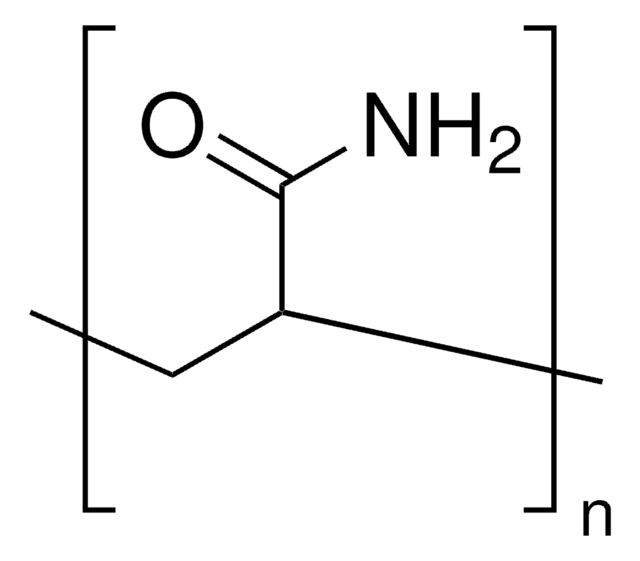Key Documents
01696
Acrylamide
for Northern and Southern blotting, powder blend
Synonim(y):
2-Propenamide, Polyacrylamide, acrylic amide, akrylamid, Acrylic acid amide
About This Item
Polecane produkty
klasa czystości
for molecular biology
Poziom jakości
gęstość pary
2.45 (vs air)
ciśnienie pary
0.03 mmHg ( 40 °C)
linia produktu
BioReagent
Próba
≥99.5% (GC)
Postać
powder blend
metody
electrophoresis: suitable
zanieczyszczenia
DNases, none detected
RNases, none detected
phosphatases, none detected
proteases, none detected
tw
125 °C/25 mmHg (lit.)
mp
82-86 °C (lit.)
rozpuszczalność
H2O: 0.25 g/mL at 20 °C, clear, colorless
temp. przechowywania
2-8°C
ciąg SMILES
NC(=O)C=C
InChI
1S/C3H5NO/c1-2-3(4)5/h2H,1H2,(H2,4,5)
Klucz InChI
HRPVXLWXLXDGHG-UHFFFAOYSA-N
Szukasz podobnych produktów? Odwiedź Przewodnik dotyczący porównywania produktów
Opis ogólny
Zastosowanie
Przestroga
produkt powiązany
Hasło ostrzegawcze
Danger
Zwroty wskazujące rodzaj zagrożenia
Zwroty wskazujące środki ostrożności
Klasyfikacja zagrożeń
Acute Tox. 3 Oral - Acute Tox. 4 Dermal - Acute Tox. 4 Inhalation - Carc. 1B - Eye Irrit. 2 - Muta. 1B - Repr. 2 - Skin Irrit. 2 - Skin Sens. 1 - STOT RE 1 Oral
Organy docelowe
Peripheral nervous system
Kod klasy składowania
6.1C - Combustible acute toxic Cat.3 / toxic compounds or compounds which causing chronic effects
Klasa zagrożenia wodnego (WGK)
WGK 3
Temperatura zapłonu (°F)
280.4 °F - closed cup
Temperatura zapłonu (°C)
138 °C - closed cup
Środki ochrony indywidualnej
Eyeshields, Faceshields, Gloves, type P3 (EN 143) respirator cartridges
Wybierz jedną z najnowszych wersji:
Masz już ten produkt?
Dokumenty związane z niedawno zakupionymi produktami zostały zamieszczone w Bibliotece dokumentów.
Klienci oglądali również te produkty
Protokoły
Poznaj podstawy blottingu Northern i Southern, wraz z protokołami i aplikacjami do przenoszenia makrocząsteczek na nośniki membranowe.
An introduction to both Northern and Southern blotting, popular methods for the transfer of macromolecules to membranous support. This article also offers a Southern blot protocol and a northern blot protocol.
Nasz zespół naukowców ma doświadczenie we wszystkich obszarach badań, w tym w naukach przyrodniczych, materiałoznawstwie, syntezie chemicznej, chromatografii, analityce i wielu innych dziedzinach.
Skontaktuj się z zespołem ds. pomocy technicznej










